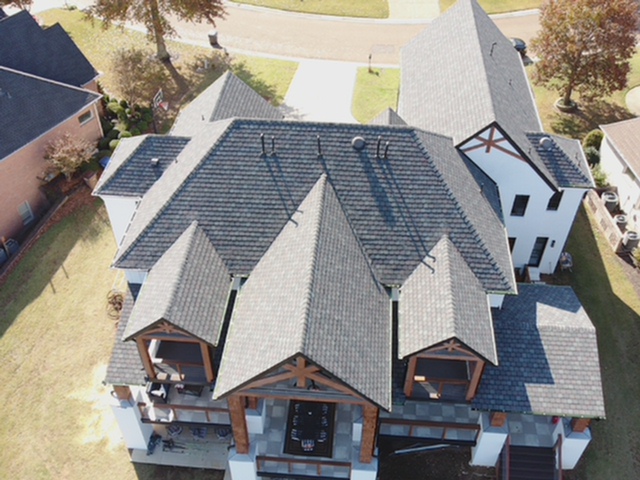A residential roof system is a crucial component of any home. It provides protection from the elements and contributes to the overall aesthetic of the house. Let’s closer look at the anatomy of a residential roof system.
Roof Deck
The roof deck is the layer of material that forms the base of the roof system. We construct the roof deck from plywood or OSB and attach it to trusses or rafters. The roof deck provides a surface for attaching roofing materials and evenly distributes the roof’s weight.
Underlayment
We install a layer of underlayment material on top of the roof deck. It is critical to the overall residential roof system. It serves several important functions. Firstly, the underlayment adds an extra layer of protection against the elements, keeping water and moisture out of the roof structure. Secondly, we use the underlayment to create a more even surface for applying roofing materials, improving the roof’s appearance. Thirdly, it helps to insulate the roof and keep the house cooler in the summer and warmer in the winter.
Roofing Materials
The roofing materials are the top layer of the residential roof system and are the most visible component of the roof. They are available in a variety of materials, including asphalt shingles, wood shingles, metal, and clay or concrete tiles. The type of roofing material chosen will depend on the style of the house, the climate, and the homeowner’s personal preferences.
When it comes to choosing the right roofing material for your home, it’s important to consider a variety of factors including durability, cost, and style. In this article, we’ll take a closer look at the different types of residential roofing materials available and their advantages.
Asphalt shingles are the most popular type of roofing material in the United States. We make asphalt shingles from a fiberglass or organic felt mat that we coat with asphalt and cover with granules. Asphalt shingles are relatively inexpensive and easy to install, making them a popular residential roof system choice for many homeowners. They are also available in a wide range of colors and styles, making it easy to find a shingle that matches the aesthetic of your home.
One of the main advantages of asphalt shingles is their durability. They can last for up to 30 years with proper maintenance and can withstand extreme weather conditions. They are also resistant to fire and algae, making them a safe and low-maintenance choice.
Wood Shingles
We make wood shingles from thin slices of wood that we cut in a uniform size and shape. We typically use cedar, redwood, or pine and these shingles are known for their natural, rustic appearance. Wood shingles are a popular choice for homeowners who want to add a natural touch to their home’s exterior.
One of the main advantages of wood shingles is their ability to insulate. They are a good choice for homeowners who live in cooler climates and want to reduce their energy costs. Wood shingles are also relatively durable and can last for up to 30 years with proper maintenance. However, they are more prone to rot and insect damage than other types of roofing materials and require more maintenance to maintain their longevity.
Metal Roofing
We make metal roofing from sheets of metal like aluminum, copper, or steel. It is a durable, long-lasting roofing material with a wide range of colors and styles, making it a popular choice for many homeowners.
One of the main advantages of metal roofing is its longevity. Metal roofs can last for up to 50 years with proper maintenance, making them a good choice for homeowners who want a low-maintenance roofing solution. They are also resistant to fire and extreme weather conditions, making them a safe choice for many homeowners. Metal roofing is also energy-efficient, as it reflects sunlight and helps to keep the home cooler in the summer.
Clay or Concrete Tiles
Clay or concrete tiles are a popular choice for homeowners who want a traditional and elegant look for their roof. They are made from fired clay or concrete and are available in a wide range of colors and styles.
One of the main advantages of clay or concrete tiles is their durability. They can last for up to 100 years with proper maintenance and are resistant to extreme weather conditions. They are also low-maintenance, as they do not require painting or sealing. Clay and concrete tiles are also a good choice for homeowners who want an environmentally-friendly roofing material, as they are made from natural materials.
Flashing
Flashing is a thin strip of metal or other waterproof material that is used to seal around any protrusions on the roof, such as chimneys, vents, and skylights. It helps to prevent water from seeping into these areas and causing damage to the roof structure.
Gutters
Gutters are an important part of the residential roof system as they help to channel water away from the house and prevent water damage to the foundation.
Soffit and Fascia
Soffit are the underside of the eaves at the roofs edge and are made of vinyl or aluminum. It helps to ventilate the attic and protect the eaves from water damage. The fascia is the horizontal board that runs along the bottom edge of the roof used to cover the ends of the roof rafters. It provides additional support for the gutter system and helps to protect the edges of the roof from water damage.
a residential roof system has several different components that working together to protect the home from the elements and improve its appearance. Understanding the anatomy of a residential roof system will help homeowners make informed decisions about the care and maintenance of their roof.
In conclusion, there are several different types of residential roofing materials to choose from, each with its own set of advantages. Asphalt shingles are a popular and cost-effective choice for many homeowners, while wood shingles provide a natural look and good insulation. Metal roofing is a long-lasting and energy-efficient option, while clay or concrete tiles offer a traditional and elegant look. It’s important to consider the specific needs of your home when choosing the right roofing material.

